The Coinage of Emperor Agustín de Iturbide
by Don Bailey
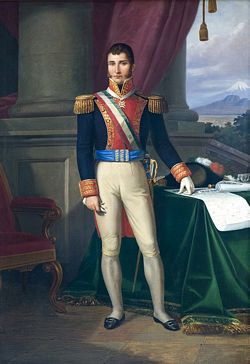 Agustín de Iturbide was born in Valladolid in the state of Morelia. He was a clerical and a royalist, and he sympathized with the idea of independence. He had fought under Trujillo at Monte de Las Cruces and shown his leadership abilities in the war with the Guerrillas in Guanajuato. In 1810 Hidalgo had offered Iturbide, an officer of the provincial garrison at Valladolid, a position in his army, which Iturbide refused and instead joined the royalists.
Agustín de Iturbide was born in Valladolid in the state of Morelia. He was a clerical and a royalist, and he sympathized with the idea of independence. He had fought under Trujillo at Monte de Las Cruces and shown his leadership abilities in the war with the Guerrillas in Guanajuato. In 1810 Hidalgo had offered Iturbide, an officer of the provincial garrison at Valladolid, a position in his army, which Iturbide refused and instead joined the royalists.
Iturbide was a very cruel leader. Within a two-month period in the state of Michoacan, he captured and shot 19 guerrilla chieftains and 900 of their followers. In 1820 he was sent on a military expedition in the South against Guerrero. The clergy who had helped Iturbide obtain this command thought that: with the crushing of the Guerrero forces Iturbide would be made Viceroy and give them a free hand.
Iturbide had his own plans- to be the Liberator of Mexico. After suffering a defeat, he decided to join the rebels. He appropriated for his personal use a train loaded with half a million pesos worth of silver. In February 1821 in the town of Iguala, he published a plan of independence whereby Mexico was to be an independent monarchy. This monarchy was to be governed by King Ferdinand, or some other prince. The church was to retain its privileges, and the Creoles and Gachupines (native Spaniards) were henceforth to be equal. These three guarantees made up the "Plan of lguala".
Guerrero, the general whom Iturbide was sent to defeat, but whom he lost to, would meet with Iturbide at Teloapan and join him by supporting Iturbide' s Plan of Iguala. Through the summer, all the forces of the liberals and royalists joined in supporting Iturbide and his plan. When the new viceroy, Juan O'Donoju, arrived in Veracruz, he was besieged, and the only way out for his family was to accept the plan. He did this in August at Cordoba.
Iturbide, now assured of success, changed the original plan; Mexico was now to be a monarchy, but not restricted to the European royal families . O'Donoju went to Mexico City and assumed the head of government position as the plan called for. Iturbide arrived there on 27 September 1821, and in October, Veracruz, Perote and Acapulco surrendered, and the Spanish army retired to the island of San Juan de Uloa. The whole country of Mexico was now independent.
On 19 May 1822, lturbide was proclaimed Augustin I of Mexico. The next year was filled with political and social conflicts and infighting that weakened lturbide' s control. He sent a message to the congress saying that he had accepted the crown only under compulsion and he now wished to abdicate. He also put in a claim for 150,000 pesos. On 19 March 1823, the congress accepted his abdication, and sentenced him to perpetual banishment.
In the spring of 1824, he informed the Mexican government that Spain was planning a reconquest and asked that he be allowed to return to Mexico to fight again for independence. The government in return decreed that if he returned he would be executed. lturbide was unaware of this decree; he had already departed on his trip back to Mexico with a supply of proclamations and paper money.
Iturbide arrived on the coast of Tamaulipas on 14 July 1824. Not knowing of the death sentence, he proceeded peacefully to the town of Padilla, where he was arrested and, after a brief trial, executed on 19 July. Iturbide became a hero among the Mexican reactionaries, while the landowners and clergy preferred to give Iturbide the credit for winning independence rather then Morelos and Hidalgo. In 1838 the remains of Iturbide were moved from Padilla to their final resting place in the Cathedral of Mexico.
The Iturbide coinage was authorized by a decree of 11 June 1822Gaceta del Gobierno Imperial de México, Tomo II, Núm. 60, 27 June 1822, but there were two measures taken in the period between independence and the coronation of lturbide. On 22 November 1821[text needed], the provisional government authorized the continued striking of Ferdinand VII coinage until new dies for the coinage of the new government could be prepared. This order specified that nothing was to be changed, least of all the date, thus, all coinage was to bear the date of 1821. However, this regulation was not followed in a number of instances. The Regency also permitted the circulation of the provisional money of Zacatecas, and by decree of 19 February 1822[text needed], its acceptance at face value was authorized. Consequently we have coinage with the Ferdinand VII effigy struck after independence.
The last date to appear on the half, one, two, four and eight Reales of the royalist Mexico City Mint is 1821. The eight Escudos gold also has the 1821 date. The November 22, 1821 decree of the provisional government decreed the dies for the colonial style coinage would be used until June 1822, but it is believed that the colonial style coinage was struck until1832 , usually with dies dated 1821. Eight Reales of this type are known to be dated 1821 and 1822 from the Durango, Guadalajara and Zacatecas mints.
All the coinage of Iturbide has basically the same design, but there are several varieties of eagles, legends and placement of assayers' initials and mintmark. There are four major bust styles of Iturbide and two major eagle styles.
½ Real

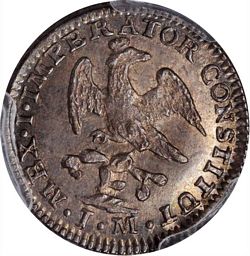
KM-301 (Stack’s-Bowers NYINC Auction, 19 January 2021, lot 22051)
The ½ Real struck in silver has on the obverse medium portrait with the legend AUGUSTINUS DEI PROVIDENTIA with the mint mark and the date below. The reverse has the crowned imperial eagle facing to the right in a sitting position on a cactus. The legend around reads MEX. I. IMPERATOR. CONSTITUT. The Assayer initials, "J.M.", appear below. There is no denomination shown on the half reales that were issued in 1822 and 1823.
1 Real
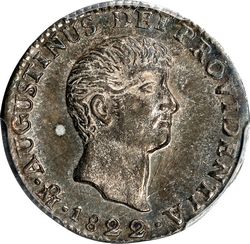
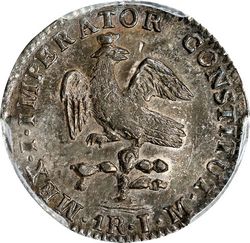
KM-302 (Stack’s-Bowers NYINC Auction, 13 January 2023, lot 21220)
The 1 Real was issued in only 1822, and the obverse is the same as the half Real, but has a wavy truncation of the bust. The reverse is the same as the half Real. but the denomination was placed below the eagle.
2 Reales
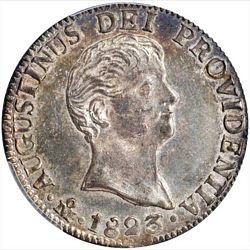
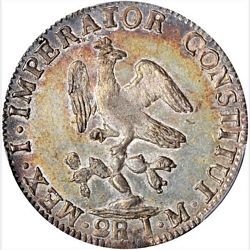
KM-303 (Stack’s-Bowers ANA Auction, 12 August 2021, lot 41170)
The 2 Reales, which were issued in 1822 and 1823, were similar in design as the 1 real, but of different treatment, again of the truncation of the bust.
8 Reales
The 8 Reales have five different obverses, and three different reverses:
Obverse 1: A small head of a youthful appearing lturbide. AUGUSTIN is abbreviated to AUGUST.
Obverse 2: A large head of a mature lturbide.
Obverse 3: Large head of Iturbide with Agustin legend spelled out as AUGUSTINUS.
Obverse 4: Has a medium head and again the full AUGUSTINUS.
Obverse 5: This has an extremely long trunk on the neck, and is rarely encountered.
Reverse A: a small upright eagle with outspread wings, facing left. The legend, MEX. I. IMPERATOR, CONSTITUT beginning at upper right. The denomination 8R and the assayer's initials, J.M.
Reverse B: A large eagle ( the same as on the minor coinage) with the legend staying the same as Reverse A.
Reverse C: Has the large eagle as in reverse B, but the legend begins at the lower left.
The eight Reales were issued in 1822 in a variety of combinations of obverses and reverses. There are 1A, 2B , 2C, 3B, and 3C. There was one with the A reverse but the bust of 1823 eight Escudos. The only type eight Reales issued for 1823 is the 4C variety, with the 1823 date.

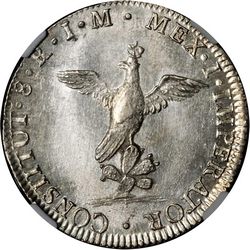
1A, KM-304. (Stack’s-Bowers NYINC Auction, 14 January 2017, lot 3146)
For varities of KM-304 small bust see Three Varieties of the 1822 Iturbide Eight Reales.
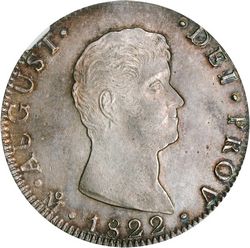

2B KM-306.1. (Stack’s-Bowers NYINC Auction, 20 January 2022, Lot 2096)
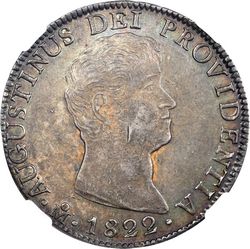
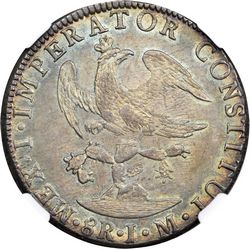
3C KM-308 (Stack’s-Bowers ANA Auction, 8 August 2017, Lot 21191)
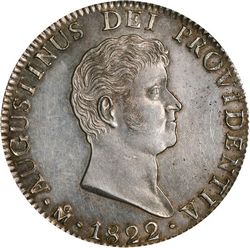
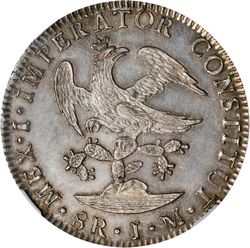
KM-309 (Stack’s-Bowers NYINC Auction, 20 January 2022, Lot 2097)

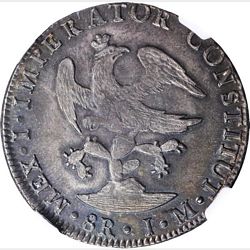
4C, KM-310. (Stack’s-Bowers ANA Auction, August 2021, lot 41168)
Gold was issued under Iturbide in four and eight Escudos denominations.
4 Escudos


Fr-61; KM-312 (Stack’s-Bowers Auction, Chicago ANA, 12 August 2014, lot 1261)
The 4 Escudos were struck in 1823. The obverse is the same as the silver coinage in that year. The reverse has a cartouche with arms containing an eagle similar to the second eagle design.
8 Escudos
The 8 Escudos were struck in 1822 and 1823.
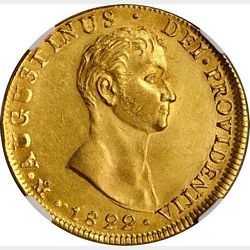

KM-313.1 (Stack’s-Bowers Auction, January 2021, lot 21072)
The 1822 eight Escudos have the obverse bust style, as the ½ Reales, and the legend on the obverse misspelled as AUGSTINUS.


KM-314. Iturbide 8E, 1823-JM, Type II (Stack’s Bowers ANA auction, 13 August 2011, .lot 21289}
The 1823 eight Escudos has the obverse the same as on all of the 1823 coinage, and a reverse the same as the four Escudos.
The assayer's initials that appear on all the coinage of lturbide are "J.M." for Joaquin Davis Madrid. There was also an assayer "J.A." for Jose Garcia Ansaldo, who served from 1812 to 1833, but his initials do not appear on the coinage of Iturbide. The edges of all Iturbide coins have a circle and rectangle pattern.
Mintage
Pradeau states that coining operations took place in five mints, and while all issued silver, only two of them were permitted to coin gold. He gives the following for the amounts struck at each mint:
| Silver | Gold | Total | |
| Mexico City | 8,605,600.94 | 505,536.00 | 9,111,136.94 |
| Durango | 965,629.25 | 965,629.25 | |
| Guadalajara | 1,614,144.25 | 51,856.00 | 1,666,000.25 |
| Guanajuato | 892,586.00 | 892,586.00 | |
| Zacatecas | 6,497,609.25 | 6,497,609.25 | |
| Total coined | 18,575,569.69 | 557,392.00 | 19,132,961.69 |
Pradeau did not find any record of any other than the Mexico City mint mark appearing on Iturbide's coinage and claimed it was possible, but improbable, that the other four mints were using dies carrying the Mexico City mint mark.
Copper coinage
During the reign of lturbide, copper coinage of 1/32, 1/16 , one eighth, and quarter Reales were twice authorized (by decrees of 11 June 1822 and 23 January 1823[text needed]), but never struck. There are eighth and quarter Reales of a regional copper issue from Durango for the province of Nueva Vizcaya. The obverse of the eighth real has a form of the coat of arms of Durango, with the mintmark "D" at the left, and the denomination at the right. The reverse has the inscription DE LA PROVINCIA DE NUEVA VIZCAYA, and the date below. The eighth real was struck in 1821, 1822 and 1823.

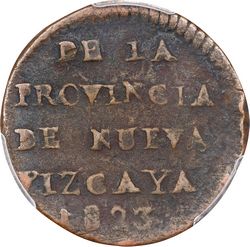
KM 299 ⅛ real 1823, Durango (Nueva Vizcaya) (Stack’s Bowers auction, 28 February 3024, lot 73103)
For more information on the varieties of the eighth real Nueve Vizcaya , see here.
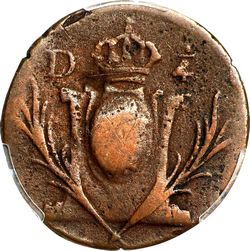
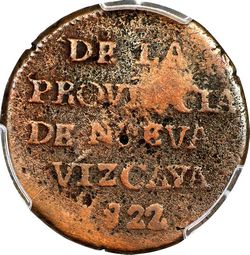
KM 300 ¼ Real (Stack’s-Bowers Auction, 19 May 2023, Lot 70222)
The obverse of the quarter Real has a different style of the coat of arms with the mintmark "D ", and the denomination at the left and right. The reverse again has the inscription DE LA PROVINCIA DE NUEVA VIZCAYA and the date 1822, which is the only year it was produced.
There were also a few provisional silver coins struck in Honduras during this reign of Iturbide. Until this time the territorial limits of Mexico reached from the northern limits of California south to the border of present -day Panama by the annexation on 5 January 1822, of the former "Capitania General de Guatemala". There were some proclamation medals issued for Chiapas, Quezaltenango, Guatemala, and Leon. At this time the only known coinage is from Comayagua and Tegucigalpa. All are dated 1823, and are known only in two Reales denomination. This annexation was terminated on 1 July 1823.
